Pierre Adler
Jean Robert Alexis
Katelyn Alexis
Jean Appolon
Ricardo Boucher
Wesner Bazile
Jerry Reginald Chery aka Twoket
Youvensky Despeignes
Ronaldo Duborgne
Anaïse Hector
Schneider Léon Hilaire
Bertho Jean-Pierre
Romel Jean-Pierre
Val Jeanty
Louis Kervens
Michel Lafleur
Love Leonce
Jean Muller Milord
Aurelien Moliere
Herold Pierre-Louis
Mario Pierre-Louis
Jean-Claude Saintilus
Reginald Senatus
Steevens Simeon
Wilerme Tegenis
Mabelle Williams
Sanba Yonel
ARGENTINA
Guillermina De Ferrari
BELGIUM
Tom Bogaert
BRAZIL
Zé Kielwagen
Marcos Serafim
BULGARIA
A.S.T.R.A.L.O.R.A.C.L.E.S
CANADA
Emily McMehen
CHILE
Montserrat Rojas Corradi
COLOMBIA
Mateo Chacon-Pino
FRANCE
A.S.T.R.A.L.O.R.A.C.L.E.S
Frédéric Grimaud
Mehryl Levisse
GERMANY
Cat Barich
Mateo Chacon-Pino
IRELAND
Jo Kimmins
ITALY
Tom Bogaert
NETHERLANDS
Àngels Miralda
PALESTINE
Aya Hasan
PERU
Miguel Velit
ROMANIA
A.S.T.R.A.L.O.R.A.C.L.E.S
SPAIN
Àngels Miralda
SWITZERLAND
Mateo Chacon-Pino
UNITED KINGDOM
Katy Beinart
Jo Kimmins
Emily McMehen
Vaughan Pilikian
UNITED STATES
Jean Appolon
Arrington de Dionyso
A.S.T.R.A.L.O.R.A.C.L.E.S
Rowynn Dumont
Sorrah ET
Val Jeanty
Guillermina De Ferrari
Laura Heyman
Lee Lee
Pierre Adler (HT), Ricardo Boucher (HT), & Guillermina De Ferrari (AR/US)
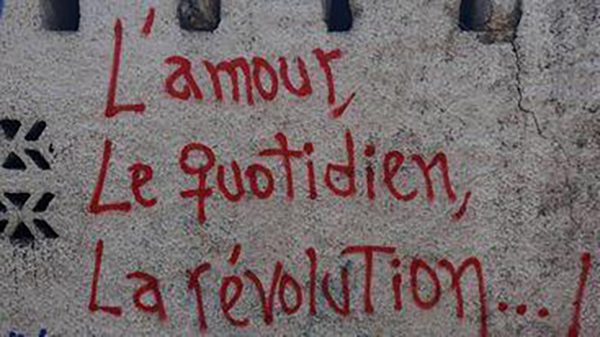
GERIZON POU NAMN | HEALING FOR THE SOUL
A beautiful phrase one encounters unexpectedly can bring clarity to the soul, offering a brief moment of reflection and peace. Someone may encounter by chance a verse that describes feelings they had no name for or didn’t even realize they had. They may feel understood, less alone, or taken by the rhythm of language that speaks to them. For the Biennale dedicated to Swen Moun, we will seek ways of bringing poetry by young Haitian poets to la Grand Rue. Preliminary ideas include projection bombing (light projections) of selected verses in Kreyòl or French, video projections, and/or recordings of readings in a simple sound installation. We will do some version of this according to what is available to us at the time—including electricity. Our goal is to share poetry as a form of care, as one of the things “we do to maintain, continue, and repair our world so that we can live in it as well as possible,” in Maria Puig dela Bellacasa’s definition of “care.” This project builds on poetic graffiti by Ricardo Boucher that I encountered during the 6th Ghetto Biennale, and that seemed to interrupt the rhythm of the city with the kind of reflection that we want to explore in new ways.
Back to artist list
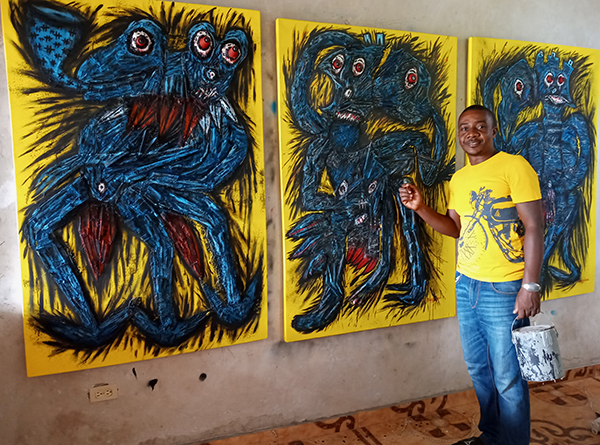
LA PORTE DU VODOU N'GANGA
It is a mini reminder that invites us to reflect on the essential essence of the human being in relation to the environment. Francois Makandal who was a slave, a Vodou priest, he is the leader of the body of the rebellions society in the north-west, insists the slaves to say there needs to be a new much more groomed and strong body that is anchored in principles such as, the protection of others and the defense of those around. I examine that if the human being was not assisted by higher spiritual forces it would already be over. a lively chat with visitors.This new conception intended to improve the known version of the human body, giving it a new position in the face of all future eventualities such as pandemics, or natural disasters, so that it is in communion with nature. This new concept translates deep inspirations based on Haitian Vodou.
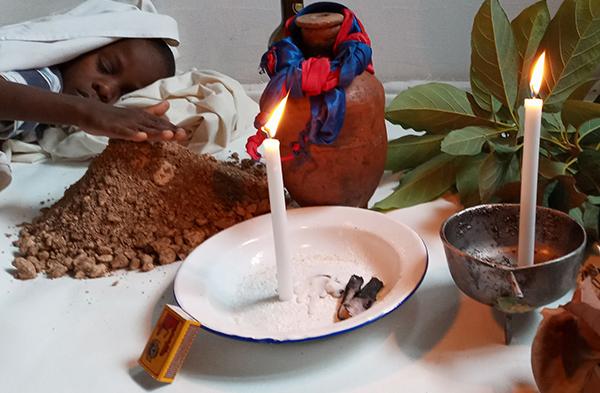
Li se yon rapèl ki envite nou reflechi sou esans esansyèl nan ke yo te imen an nan relasyon ak anviwònman an. Francois Makandal ki te yon esklav, yon prèt Vodou, li se lidè kò sosyete rebelyon yo nan nòdwès la, ensiste esklav yo pou di gen bezwen yon nouvo kò ki pi swaye e ki pi fò ki ankre nan prensip yo. tankou, pwoteksyon lòt moun ak defans moun ki ozalantou yo. Mwen egzamine ke si ke yo te imen an pa ede pa pi wo fòs espirityèl li ta deja sou. yon chat vivan ak vizitè yo. Nouvo konsepsyon sa a gen entansyon amelyore vèsyon li te ye nan kò imen an, ba li yon nouvo pozisyon nan fè fas a tout evantyalite nan lavni tankou pandemi, oswa dezas natirèl, se konsa ke li se nan kominyon ak lanati. Nouvo konsèp sa a tradwi gwo enspirasyon ki baze sou Vodou ayisyen an.
Back to artist list
Katelyn Alexis (HT), Wesner Bazile (HT), Patrick Elie aka Kombatan (HT), Aurelien Moliere (HT), Jean-Claude Saintilus (HT) & Wilerme Tegenis (HT)
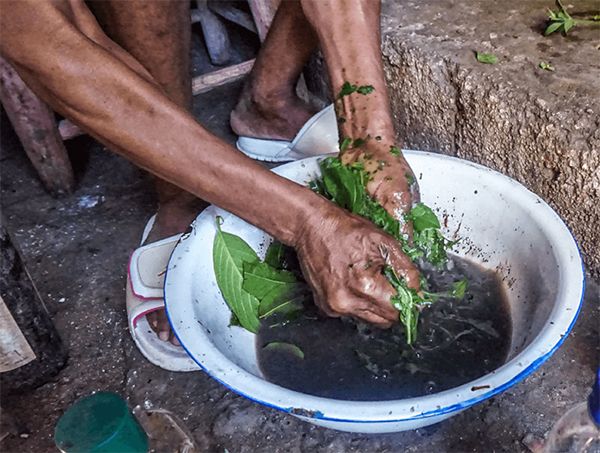
GERIZON AFRIKEN | AFRICAN HEALING
We are planning a group project looking at how a community can heal itself using African heritage knowledge.
Nap planifye yon pwojè gwoup kap gade ki jan yon kominote ka geri tèt li lè l sèvi avèk konesans eritaj Afriken yo.
Back to artist list
Jean Appolon (HT/US) & Val Jeanty (HT/US)

GÉRIZON LAKAY | HEAL THE HOUSE
GÉRIZON LAKAY will explore how art and creativity can provide pathways toward healing through self-expression. Through integration of connection, movement, and sound, participants will learn to express themselves in new ways, and have the opportunity to create a significant work of art. The work, an expression of home, community, understanding, and connection, will demonstrate how connecting to self and others contributes to swen moun. Participants will join Appolon and Jeanty in guided discussions, movement and sound workshops, and finding connections between people, places, sounds, and movements. Workshops will provide opportunities for yoga, meditation, Haitian folkloric and modern dance, and sound exploration. Improvisation will be presented as a way to process pain and find healing. Appolon, Jeanty, and Ghetto Biennale residents will express their spirituality, creativity, ancestry, community, and pain through sound and movement. Participants will create original choreography, fusing Haitian folkloric movements with contemporary movements. Community members will find ways to take on leadership roles, demonstrating the power of movement and expression for healing. The resulting choreography will be infused with traditional Haitian folkloric dance and renowned modern techniques: the Horton technique develops dancers’ strength, flexibility, and musicality; and the Dunham technique, created by Katherine Dunham, based on the continual motion rooted in Caribbean and African cultures.
This healing process will culminate in a dance production with accompanying music, performed by residents of Ghetto Biennale and other Haitian partners. Appolon and Jeanty will support the site-specific presentation, entitled GÉRIZON LAKAY, which will provide participants new ways to express themselves, share their feelings, and move to find peace and enjoyment.
Back to artist list
A.S.T.R.A.L.O.R.A.C.L.E.S (BG/FR/RO/US)
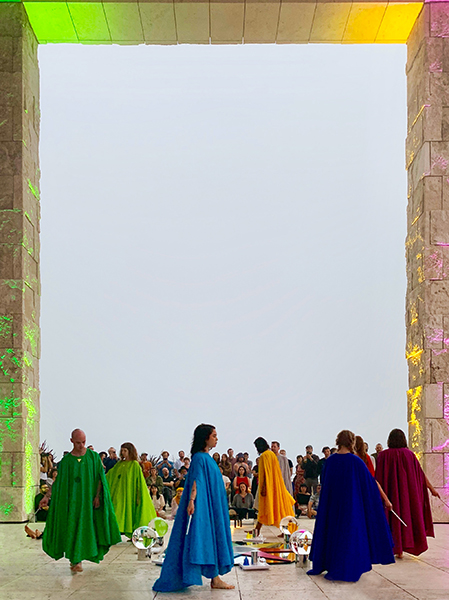
OMNIDIMENSIONAL RITUAL
A.S.T.R.A.L.O.R.A.C.L.E.S is an international open source metaphysics community that was founded in 2018, with Oracles and nodes in Los Angeles, Plovdiv, Bucharest, and Paris. We exist as an ever evolving non-system that continually generates new methodologies of gathering humans and beings together on spiritual terms - without hierarchy, dogma, or universal truth. We constantly seek to discover how we can meet each other in shared spaces, while respecting and honoring our individual beliefs and traditions. We have an omnidimensional worldview, in that we believe all cosmologies, dimensions, universes, entities, and realities exist each in their own realms individually while being interconnected - yet we currently reject the notion that they are all manifestations or expressions of one source.
Our main focus at the moment is aligning with eleven dimensions, although we believe there are a near-infinite host of them. These eleven primarily pertain to the linear journey of the human experience and the phases of existence that occur before and after this life. We align with these sentient frequency fields through ceremony, various divination methods of receiving transmissions, and through our many technologies that activate the physical and aethereal senses. Our technologies include architectural spaces and components; vestments; quantum perfumed balms, oils, and incense; jewelry; essences; music; tea; and other ritual accoutrements.
We will present our technologies and a ritual or ceremony in a space that opens to us.
Physical, psychic and astral healing is certainly a by-product of our activities, however we reject the predominant contemporary metaphysical healing paradigms, because they point to the idea that one will never be truly healed or whole in this life, that one has to wait for this state of being until heaven or nirvana or ascension. We believe that everyone at their core is divine as they are, and that all they have to do is witness that part of themselves and integrate it into their waking dream.
Following our open-source framework, the Port-au-Prince apparition of A.S.T.R.A.L.O.R.A.C.L.E.S will be regenerated or adapted into a new node. The cosmology, signs, and ideas within this community will perpetually evolve and expand, never being constant or fixed.
Back to artist list
Cat Barich (DE)

DOCTO BET | ANIMAL DOCTOR
Animals play an important role in Haitian revolutionary history, vodou and folklore. There is an unquestioned belief that humans seem to be able to shapeshift into animals and back. In ceremonies animals are sacrificed as a gift to the loa and communally eaten. This practice is transformational, nourishing and healing.
Mahatma Gandhi once said that "the greatness of a nation and its moral progress can be judged by the way its animals are treated." DOCTO BET seeks to reduce the suffering of those who are completely under one's domination, and unable to fight back. This trying to raise awareness of how to respectfully raise, treat & live with the local animals, to increase their wellbeing and through that heal an ancient relationship that was broken by capitalism and poverty. This project will take place in an informal manner throughout the biennale.
Back to artist list
Katy Beinart (GB) & Mabelle Williams (HT)
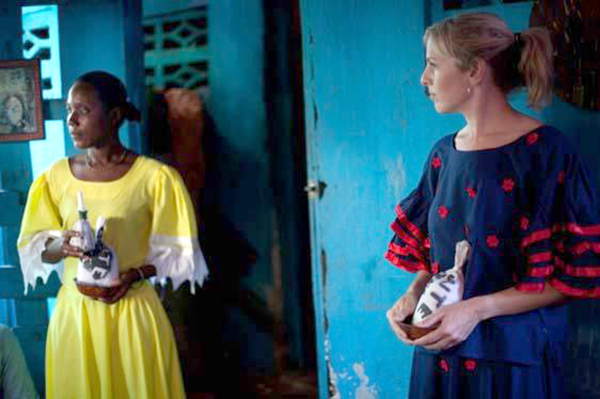
GOUTE SEL SUITE | TASTE OF SALT SUITE
In 2013, we took part in the Ghetto Biennale, with the “Goute Sel” project and performance. For this Biennale we present our project “Goute Sel Suite”. We will make a comparison between places, by re-making elements of past performance, and documenting these. Through our artistic collaboration, we will show the importance and the usefulness of salt in the medical and healing field, whether traditional (archaic) or scientific, in the Vodou, in the culinary arts etc. We will explore salt rituals that include different forms of healing, and develop our own forms of rituals. Our collaboration also explores difference, and the opacity of the Other, as written about by Édouard Glissant in his book Poetics of Relation (Poetique de la Relation) and we will also refer to Glissant’s book of poems, Black Salt (le Sel Noir) in our project.
Back to artist list
Tom Bogaert (BE/IT) & Michel Lafleur (HT)
FAMASI MOBIL (WOTASYON) | MOBILE PHARMACY (ROTATION)
BONBON TÈ MAJIK | MAGICAL MUD CAKES
Michel Lafleur and Tom Bogaert are two artists who work together as the collaborative art duo Lafleur & Bogaert. They began creating art together in 2013 when they met at the 3rd edition of the Ghetto Biennale in Port-au-Prince, Haiti.

For the 7th Ghetto Biennale / Swen Moun (Heal People), Lafleur & Bogaert will continue to work on their series of sculptural portable pharmacies. After the “Famasi Mobil Swiss” and the “Famasi Mobil Kongolè”, and inspired by the serpent-entwined Rod of Asclepius, they will work on several rotating mobile pharmacies: the “Famasi Mobil (Wotasyon)”. Mobile pharmacies are the main source of medicine for many Haitians, and street vendors carry spires of curved paper covered with pills including painkillers, antibiotics, Viagra knockoffs, condoms, abortion pills and cough syrups. The “Famasi Mobil (Wotasyon)” will include electric lights, cardboard, decorated plastic buckets, multi-coloured pills, a spin mop, rubber bands, and pairs of scissors.
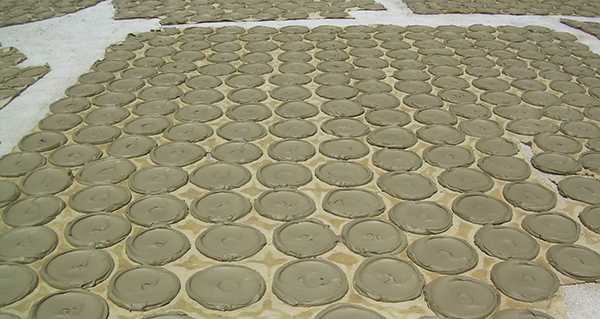
In addition, Lafleur & Bogaert look forward to starting their research and production on “Bonbon Tè Majik”: Haitian mud cakes decorated with hand-painted historical revolutionary scenes. While the myth exists that people in Haiti have had to resort to eating dirt due to extreme poverty, the reality is that mud cakes, or ‘bonbon tè’, are traditionally used as a dietary supplement — typically during pregnancy, because of the mineral content of the mud. Lafleur & Bogaert will gather dirt from Haiti's central plateau, near the town of Hinch, and truck it over to the Biennale site. Experimenting with different recipes, motifs, and designs, they will make the cakes on site and offer them to the public who can then eat or collect the “Bonbon Tè Majik”.
lafleur.bogaert.com
sfai.lafleur.bogaert.com
Back to artist list
Mateo Chacon-Pino (CO/CH/DE), Àngels Miralda (CAT/NL) & Montserrat Rojas Corradi (CL)
COLLECTIVO OLLA COMÚN | POTLUCK COLLECTIVE
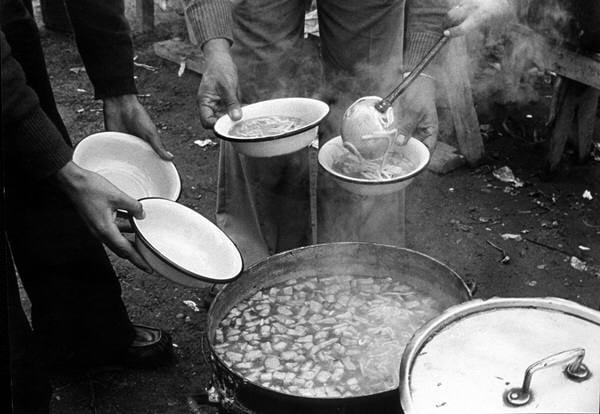
COLECTIVO OLLA COMÚN is a curatorial project that proposes the practice of popular canteens and community meals as a curatorial method. The Olla Común is a typical self-organized neighbourhood activity that often arises in Latin America in the face of scarcity. During the last year of pandemic this practice has revived in many places where communities stepped up to support themselves where state infrastructures failed. For the process we have invited the Colombian collective la agencia to create temporary structures for meal-based gatherings. La agencia proposed that the Olla Común has similarities to the indigenous South American practice of Minka - a self-initiated organisation of labour in agricultural societies where work is done not for wages but for the common harvest. Artists will be invited to activate the spaces with performances, readings, music, and temporary exhibitions such as Ayrson Heraclito (BR), Nina Emge (CH), Asli Hatipoglu (TR/TH/NL), and Abelardo Augusto (CL/HT). The space operates in a state of flux that allows visitors and interested artists to intercept and intervene, becoming part of the project participants. The curatorial method of Olla Común proposes a fluid structure in which each ingredient contributes to the final presentation in a soupy loss of individuality.
Back to artist list
Jerry Reginald Chery aka Twoket (HT) & Ronaldo Duborgne (HT)
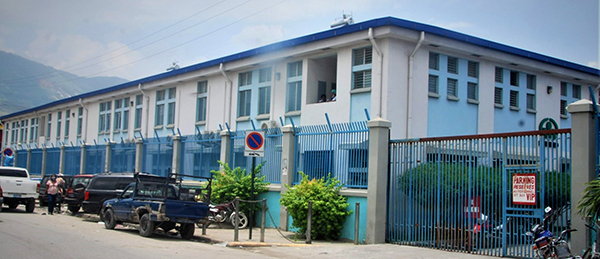
NOU BEZWEN SWEN | WE NEED TO HEAL
NOU BEZWEN SWEN se pwojè de atis rezistans ki mete tèt yo ansanb pou nou reyalize yon bèl zèv atistik nan lakou tòkèt ki sitiye nan ri di sant , zèv atistik sila pral montre tout sitiyasyon peyi dayiti nan zafè swen moun pèfòmans nou pral bay la se yon bagay ekstra òdinè nou pral sèvi ak zèv atistik sa pou nou montre ke Ayiti se yon peyi ki nan ijans ki nan nesesite swen sitou pou sila kap viv nan anndan Geto yo !!! Viv Geto Byenale an AYITI - PÒTOPRENS!
WE NEED TO HEAL is a project that two members of Atis Rezistans are collaborating to produce a beautiful work of art in Twoket’s yard which is situated on the Hospital Road, and it will show all the situations in Haiti based on healing people. We will create extraordinary things and use this work of art to show that Haiti is a country which is in a state of emergency and needing care…especially for those living in the ghettos. Long Live Ghetto Biennale in HAITI – PORT-AU-PRINCE
Back to artist list
Youvensky Despeignes (HT), Anaïse Hector (HT), Shneider Leon Hilaire (HT), Bertho Jean-Pierre (HT) & Reginald Senatus (HT)
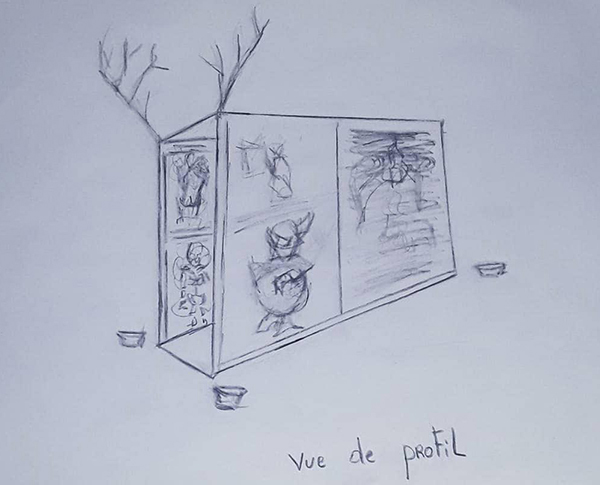
PASAJ | PASSAGE
We understand the term passage as the action of passing and place where one passes. As part of our project, we are adding the notion of the "state of shock", initially fleeting but dragging on, in which the world, our country, the economy and our culture are immersed.
Therefore, our project will consist of a tunnel 96 inches long and 98 high. Its width will be 48 inches and the spectator will be able to pass through it. Rectangular in shape, the tunnel will feature different works (acrylic on canvas, engraving and inking) on each of its walls. On the ground, pots of traditional medicinal plants will be placed so as to indicate the way. Viewed from the front, the tunnel will look like a tree. And the entrance will consist of a liana curtain. At each end of the installation, there are symbolic representations of the 4 elements. The roof will be made of sheets from recycled materials.
This tunnel, this passage will represent all the intensity of the treatment process, the stages and the trials that lead to healing; whether physical, psychological, abstract or metaphorical, with the contribution of the 4 elements, medicine and our folklore.
Back to artist list
Arrington de Dionyso (US) & Love Leonce (HT)
ENPWOVIZASYON AK GERIZON | IMPROVISATION AND HEALING
Arrington de Dionyso (based in Olympia, Washington USA) brings an extensive toolkit as a painter, poet, and musician. He aims to channel Spirit while embracing the risks of free improvisation, an inheritor of both punk minimalist iconoclasm and the ecclesiastics of the 1960’s free jazz era as exemplified by Albert Ayler, Eric Dolphy, and Sun Ra. His travels through SE Asia, North Africa, and Siberia have also brought him directly into contact with both traditional lineages and avant-garde explorers who use music as a vehicle for entering trance states in which healing takes place for individuals and entire communities. The Sound is the Medicine.
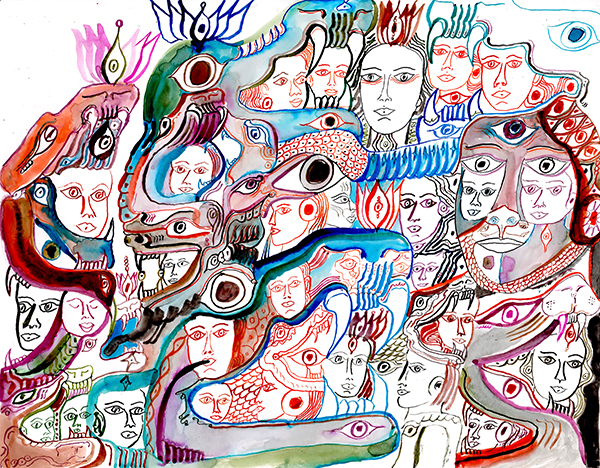
Love Leonce is a painter, DJ, and a leader of the Timouns Rezistans Collective in Port-au-Prince. He conducts painting workshops for children in some of the most impoverished areas in Haiti, while teaching painting techniques integrated with principles of Vodun spirituality, he cultivates a space for healing, strength, and self-esteem for some of the most vulnerable members of Haitian society.
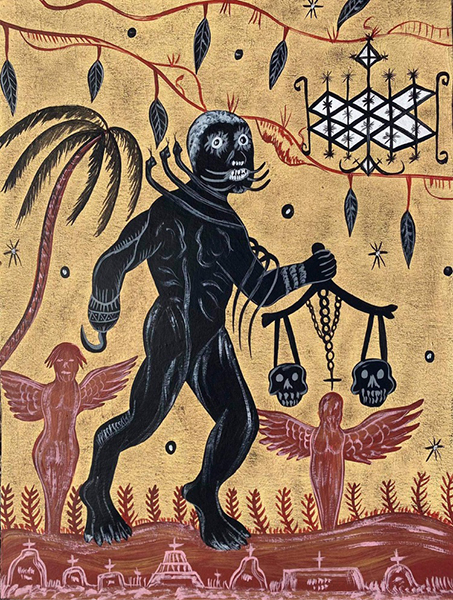
Our collaboration for Geto Byenal will bring our skills together in the creation of something that has never been seen before, in an exhibition of painting, musical sculptures and performance with a stop-frame animation created during our time of working together collaboratively. During his time in Haiti, Arrington will also be available for one on one Sound Healing sessions open to anyone.
LoveLeonceArt.facebook
arrington.bandcamp.com
Back to artist list
Rowynn Dumont (US)
SWEN MOUN | HEAL PEOPLE
“Following ideas, images, sensations and intense affects charted by William James, Alfred North Whitehead and Gilles Deleuze, Brian Massumi invites us into an aesthetic meditation that is also a meditation on art” - James Williams on Massumi’s Semblance and Event: Activist Philosophy and the Occurrent Arts.
The process of healing requires a course of action. Repetitive meditative movements created with the intent of living within the moment, opens a space for living, breathing and existence within the tangible world. My goal with this project is to compose an ongoing performative action which involves the community of artists in Port-au-Prince. The idea is to seek empowerment through a shared communal presence. The action itself would act as a symbolic crossroads, uniting the four elements, earth, fire, water, and air. The objective is to fashion a space of stillness, within the chaos, towards a purpose of learning to ask the right questions. In doing so there is a space for healing to begin. Kristeva traces the horror of the abject in the realms of religion and art. Human culture naturally attempts to purify the abject, or in the very least contain it. Abject often leads to issues with what Kristeva labels “primal repression,” within an individual and a community or society as a whole. Our own materiality or the thought of it, can cause breakdowns, riots, and physical reactions through illness. Through meditative aesthetic expression, the abject can be faced, dealt with, and worked through.
• The piece itself would be a performance of repetitive action, created with the idea of aesthetic meditation as a tool for healing.
• This work would be conceived in union with the community of artists in Haiti at the event. It is an interactive experience.
• As I will create the project in Haiti, I would like to document it with Polaroids.
• Prior examples of this can be seen in the performance art piece titled "350 Victims, 233 Unidentified," in 2005 at the Mexican Art Museum in Chicago. Artists who lived and worked in the community came together. They silently sewed all the names of the women who had been killed in Juarez for working in the factories and taking men's jobs.
Back to artist list
Sorrah ET (US)
GET USED TO THIS
My first trip to Haiti was intended as a cure of sorts. My dad and stepmom sent me to a missionary camp for troubled teens in the hopes that I’d come back Christian, straight, and grateful. I’d been removed from my single, mentally ill mother’s care and placed with them, and I hadn’t been adjusting well. GET USED TO THIS, to us, they were trying to tell me. Instead, I got cholera, spent three days in a tent hospital, and emerged with the understanding that no matter how bad things got for me elsewhere, I would never be homesick. I was sick of home and getting better from that would mean giving up something I wasn’t willing to lose. So, I more or less ran away to Haiti. That’s where I was when neo-Nazis killed someone in my hometown of Charlottesville, and I couldn’t escape that I should’ve been stateside instead. Then my mom died by suicide before she had the chance to take the trip to Haiti she’d been talking about. Her funeral consisted of us eating crackers and cheese with the women at the shelter where she’d stayed when she wasn’t living on the streets. I don’t know how anyone heals from that, but I did decide I can’t act like I’m someone for whom this hadn’t happened. Living outside D.C., I have had ample opportunities to become involved in counterprotests and mutual aid. My main motivation has always been to build a world my mom could have survived in. I told my friends and family in Haiti I’d still come back at least twice a year. Then the pandemic hit, so I haven’t been back since the last Biennale. So I’m proposing a homecoming of sorts. I’ll visit the people I love, in the places where they welcomed me. In the process I’ll play around with land, with things having to do with embodiment and politics. Like the line “Every last inch of me shall perish. Except one…and it's the only thing in the world worth having” that I can’t help loving from V for Vendetta, and “not a centimeter of land has been lost, because the land is the lifeblood of a family. Not a centimeter has been gained, because other families have a right to live, too”, a line from a children’s book by Haitian author Zermatt Scutt. Meanwhile I won’t neglect water – the thing my mom wanted most for us was to go whale-watching, and I’ll see if I can swing that, to show how I would have introduced her to Haiti, and Haiti to her. I’ll collaborate with a Haitian filmmaker-friend to capture these lived moments, so I can combine them with scenes from protests in both the U.S. and Haiti, alongside the tangible objects people use to mourn. Rather than a film to be shown at a screening event, I’m envisioning something that can be displayed in a place, that can take up space alongside these other artifacts.
Back to artist list
Frédéric Grimaud (FR) & Steevens Simeon (HT)
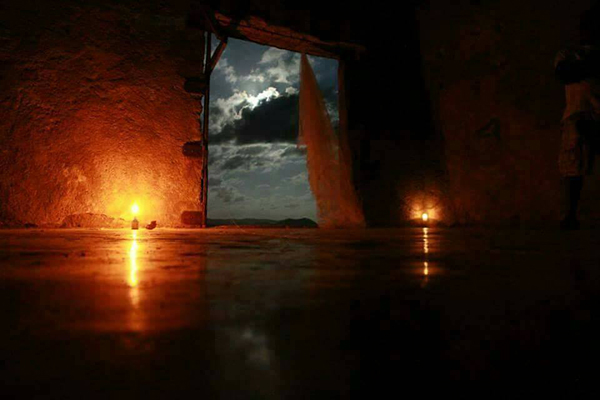
JUST BELIEVE | JIS KWÈ
In this project, I want to work on Voodoo in Port‐au‐Prince, to tell the link that this practice has with the population, their health (psychological, physical…), their mode of healing and universal forces. I will also offer photographic workshops to teach Atis Rezistans members how to use photographic equipment to make professional images of their works.
Back to artist list
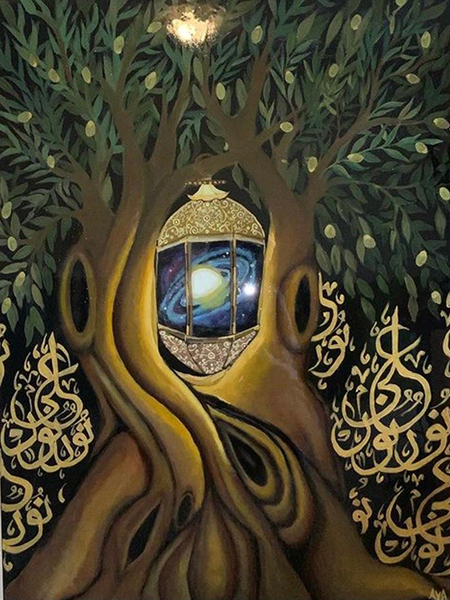
THE PALESTINIAN OLIVE TREE | PYEBWA PALESTINYEN AN
The color of their skin, the smell of their hair, medicine to their bodies and the taste of their food. An ancient tree with roots so deep and valuable. The Palestinian olive tree tells a tale of healing, sacrifice, unity and persistence of the indigenous people of the land. As a Palestinian artist, I aim to bring a model of the wise tree to life based on my interpretation of the olive tree mention in holy scriptures of the Quran ( Surat Al-Nur [24:35]). The purpose of the piece is to highlight the value of the olive tree to the spiritual, mental and physical life of the Palestinian people. It aims to show how the the green golden oil that seeps through the fruit of this tree is a medicinal fuel to the body and soul. The Palestinian olive tree model will contain golden olives to represent the value and age of the tree as it fuels a Palestinian lamp that sits in its center to show origin. The ultimate aim of the project is to inspire people to refer to what natural medicinal resources for spiritual and physical healing I order to reduce the great dependence on western medicine and to seek other alternatives that are as old and valuable as our land and culture.
Back to artist list
Laura Heyman (US)
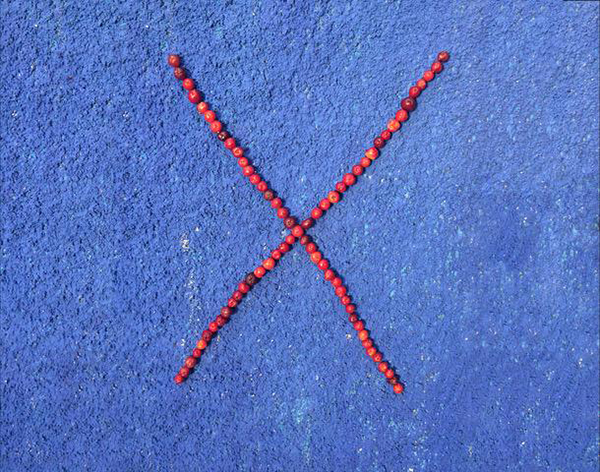
THE REMEDY ALPHABET | ALFABÈ A REMÈD
Images of fruits and vegetables and bounty from farms appears as common design element in various places in the home, most often in the kitchen. These design motifs also show up in instutional settings like schools or hospitals in various forms, such as the food pyramid, found in health textbooks and school cafeterias in the U.S., and the nutritional alphabet chart, found in kitchens throughout the UK and Europe.
The Remedy Alphabet references and repurposes these motifs to create a crowd-sourced version of the alphabetical food chart featuring home remedies shared by members of the Grand Rue community. The chart displays a fruit or vegetable for each letter and lists the vitamins, minerals and other benefits of each food pictured. Heyman’s practice includes photography, sculpture, video, print and installation. Here she continues recent experiments with publishing (previous projects include political pamplets and newspapers), creating a mass produced fold-out alphabet chart illustrated with local medicinal foods.
Back to artist list
Romel Jean-Pierre (HT)
TE A PARE | TEA CEREMONY
The term “tea ceremony” usually conjures up mental images of formal rituals in old Japan, or more modern ones in India or Malaysia where business deals are struck over a pot of tea and a handshake. Based on the occidental genesis version of tea creation, drinking tea is a tradition that's said to date back to 2737 BCE, when, according to legend, Chinese emperor Shennong found his hot water was greatly improved when a dried leaf fell from a plant into his cup. Since then, tea drinking has spread around the world. However, when I investigated the African Tea traditions, I realized the tea consumption in African culture is an intentional cure and healing process.
In Haiti’s streets every morning you can hear some street merchants passing by and yelling ‘Welele TE A PARE Oi!’ The tea is ready, you can stop them and buy a cup of tea that's meant to help your blood pressure while talking to them about your house problem or health care problem, that merchant de-facto became your physical and mental healer.
My plan for this Ghetto Biennale in accordance with the Theme “Swen Moun” is to combine west African Senegalese ancient tea ceremony who goes by the name “Attaya” with Haitian tea tradition and do a tea ritual Performance.
I will set a space with a table and 2 chair with 6 teapot that will contain Haitian traditional healing teas, I will be sitting on one of the chair and people will be invited to seat with me for 10 minutes, I will start by asking you a few question about your health and mood, depending on your answer I will serve you a specific tea from one of the teapot, then you will be able to have a conversion with me about any subject of your choice, at the end I will let you go with a Haitian proverb that seem appropriate based on our conversation.
To select the tea and the proverbs that will be used during the performance, I will be meeting elders and traditional healer (doktè fèy) of the community and ask for suggestions and guidance. Participant will be invited to leave an honest review of the tea service/ritual, a little book of the fey and the combined proverb will be created, and a little book of the fey and the combined proverb will be created.
With this process I intend to take away the capitalistic prospective of tea consumption as being a purely transactional exchange between a consumer and a corporation to give it its African meaning of being a ritual intended to give relief to the body and soul and encourage dialog and wisdom.
Back to artist list
Louis Kervens (HT)

SWEN NAN MIZIK | CARE WITH MUSIC
A collaboration making music on the theme biennial. We ask what is happening to the country if we giving care through music?
Yon kolaborasyon fè mizik sou tèm byenal la. Nou mande sa k ap pase nan peyi a si nou bay swen nan mizik?
Back to artist list
Zé Kielwagen (BR), Marcos Serafim (BR), Steevens Simeon (HT) & Sanba Yonel (HT)
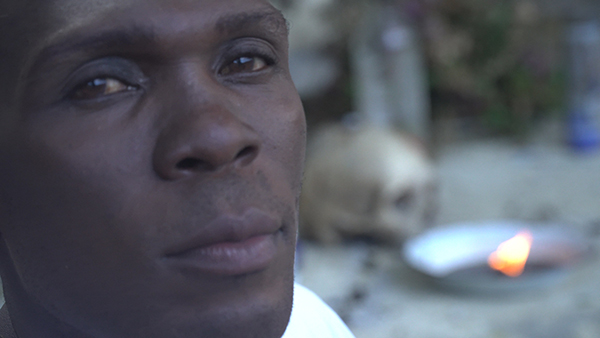
KOLE SAN DANJE: PÈFÒMANS, FOTOGRAFI, AKSYON | SAFE TOGETHER: PERFORMANCE, PHOTOGRAPHY, ACTION
Since the beginning of the AIDS crisis in the 1980s Haiti has seen an increase of homophobic discrimination and violence. LGBT+ folks are often blamed for the high HIV rates in the country, as well as for natural disasters, both interpreted as divine punishment. Through song, dance, drag and photography, we want to discuss sexual health and homophobia in Haiti. We will produce and present an original performance by Sanba Yonel and a new photographic series by Steevens Siméon. Yonels performance will feature traditional Haitian song and dance, a lip-sync to a song by a Haitian diva and a talk about safe sex, STD prevention and treatment, access to health services, and the struggles of LGBT+ folks in Haiti. Siméon will document Yonel´s performance and propose further actions to be executed for the camera, in order to create a new series of photographs to be displayed at the Grand Rue.
facebook.steevens.simeon
kielwagen.art
serafimn.msu.com
facebook.yonel.charles
Back to artist list
Jo Kimmins (UK/IE)
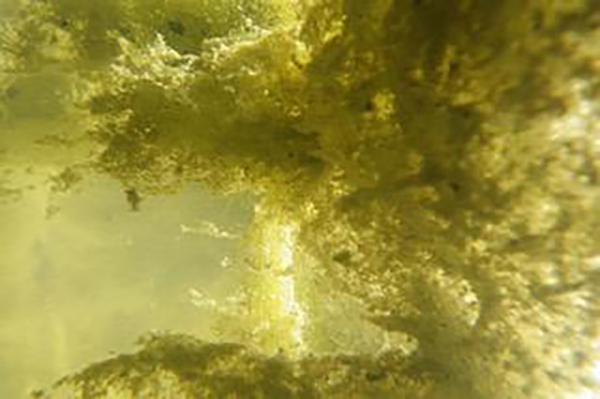
SACRED WATERS | DLO SAKRE
Water holds the secret of life and is the vibrating energy that unites us all. By investigating and penetrating this transient world of water and light, I will attempt to reveal water’s mysteries, in order to transfigure the ordinary and the quotidian into the wonderful and extraordinary. Water’s flow constantly links life and death. It is the medium between the two, and its surface provides a common frontier in nature where they meet. Since time immemorial water has been considered to hold mysterious, healing, magical powers. Sacred springs and wells exist in every corner of the earth. Haiti is no exception as hydrolatry is a very important part of Haitian beliefs. For example, during the Festival of Our Lady of Carmel, July 14th–16th at Haiti’s most sacred water place, Saut d’Eau, people come from all over Haiti to wash in the waters and be cured of physical illness, social and psychological issues.
In order to create work for the exhibition I will spend the three weeks prior to the Biennale visiting the sacred waters of Haiti. Each sacred water would have its own case study with an in-depth lens based investigation both above and below the water searching for water’s elusive ethereal magic. A field recording will also be made at each site. The photographs alongside the acoustic recordings will be the basis of my exhibition. My images are a contemplation and a connection with something beyond the norm of everyday life. In Haiti I want to create a contemplation into the magnitude and marvels of water.
Back to artist list
Lee Lee (US)
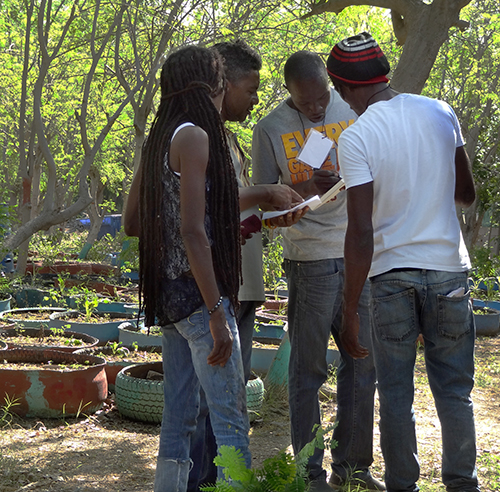
PLANT HEALING | GERIZON AK PLANT
In extraordinary acts of preservation, endemic plants considered sacred to indigenous Taino are tended in microgardens throughout the Grand Rue. When the first escaped Africans were received by Taino in the rugged mountains, they learned healing relationships with native plants. We will expand these microgardens that flourish around the neighborhood.
*
Moringa was considered important enough for Africans to sew seeds into the hems of their garments whilst being forced from their homelands. The trees have adapted to their new island easily, thriving even out of parched, rocky or salty soils without becoming invasive. The leaves offer a nutrient dense supplement to a diet heavy on refined wheat, a primary cause of diabetes. We will plant Moringa in three ways; sow seeds, grow roots from cuttings and plant young trees sourced from local nurseries.
*
Continuing our tradition of shared meals, we will explore vegetable heavy Haitian recipes through a series of pop up lunches prepared by neighborhood grandmothers. These meals have been an important time to share stories and slow down to enjoy time together.
*
Providing a platform for plant stories, we will develop an interactive Green map that shows where to source the supplies/ingredients/plants for each part. Histories and recipes will complement information like instructions for propagating Moringa or uses for medicinal plants.
Back to artist list
Mehryl Levisse (FR)
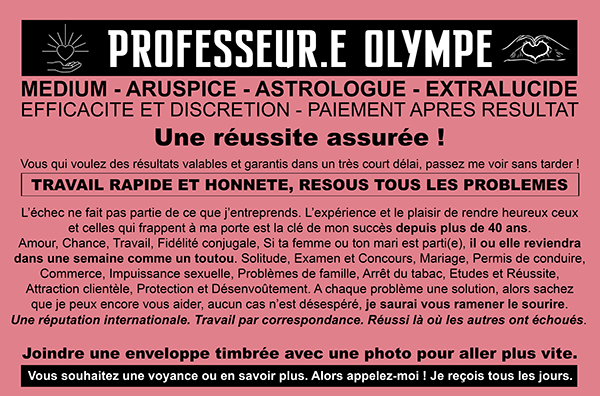
PROFESSEUR.E OLYMPE
Charlatan (dictionary definition) male name
1. Formerly : street vendor selling drugs, pulling teeth
2. Impostor who exploits public credulity
3. Name always masculine, even to designate a woman
PROFESSEUR.E OLYMPE, is a character created and imagined for the 7th Ghetto Biennale.
It dressed in a full pattern costume (mask, clothing, gloves, accessories) who be look like a fortune teller or card taker. PROFESSEUR.E OLYMPE is created on site, and be designed to be activated several times at specific times and chosen during the biennial. Visiting cards indicating the presence of PROFESSEUR.E OLYMPE will be circulated from hand to hand during the biennial. The "e" present in PROFESSEUR.E OLYMPE'S name establishes gender parity in her person, the pronoun to qualify PROFESSEUR.E OLYMPE is neither "he" or "she" but "it". PROFESSEUR.E OLYMPE is non-gendered and is PROFESSEUR.E OLYMPE human? Nobody knows.
Back to artist list
Emily McMehen (HT)
SAN GWEGWA | ST GREGOIRE
My proposal for the Ghetto Biennale is to prepare two large textile works depicting St Gregoire. They will comprise of found textiles (provided), PPE such as masks, gloves and gowns (provided) and locally sourced textiles. One of these will be based on the Icon of St Gregoire depicted standing next to a sickbed with a briefcase, and dressed in a blue suit. The classic image will be broken into a grid, and I will hand out fragments to anyone who wants to participate. Participants can take whatever textiles they would like to use and add anything of their own to recreate the fragment using their own interpretations. The fragments will be assembled into an ‘exquisite corpse’ style of image.
All ages can participate in both projects. I will provide a sewing machine, and basic sewing supplies. It is expected that the sewing technique will mostly be a very rough basting using thick and sturdy, visible thread. If anyone who wishes to participate would like to do finer work, or add more finished details, these would of course be welcome.
Back to artist list
Vaughan Pilikian (GB)
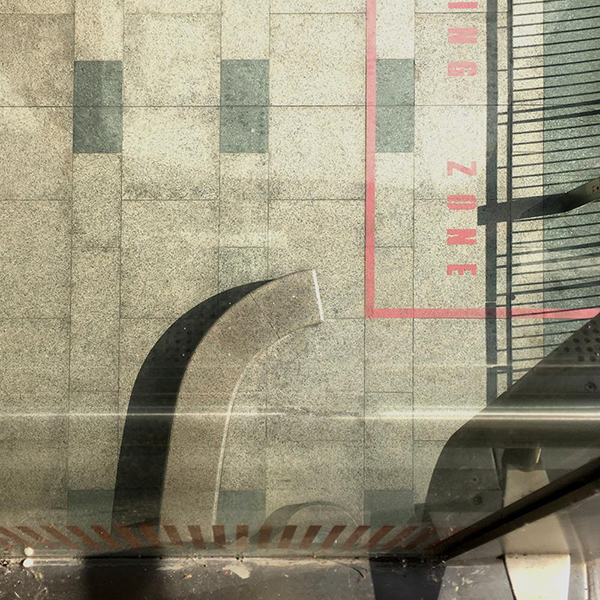
THE SQUARE | KARE A
Virus as metaphor.
At the heart of world culture is the void, which is not an aesthetic fact but an ontological one. The void is a non-cosmos. Around it like a shimmering cloud of phosphorescent insects are the bilions of individuals tapping and tweeting. One for every dollar stolen and locked at the centre.
At the heart of the city of Port-au-Prince opens a square. The square is a clearing, like a glade in a forest. Within it can be bound together the impossible: the living and the dead, the spirit and the flesh, the past and the present. Inside the square there enfolds the encounter between two unknowns.
Here the wound become the healing, the sickness health. In the collision of opposites we try to imagine, for a moment, the shape of hope.
Back to artist list
Miguel Velit (PE)
PERUVIAN SHAMANS CURE COVID 19 IN HAITI
Peruvian Shamans Cure Covid 19 in Haiti. My project has to do with shamincos rituals to cure people with
medicinal herbs and ayacuasca which makes the effect of bringing out the spirt of the beings and cures it with primitive natural treatments.
Back to artist list
Elizabeth Woodroffe (GB)
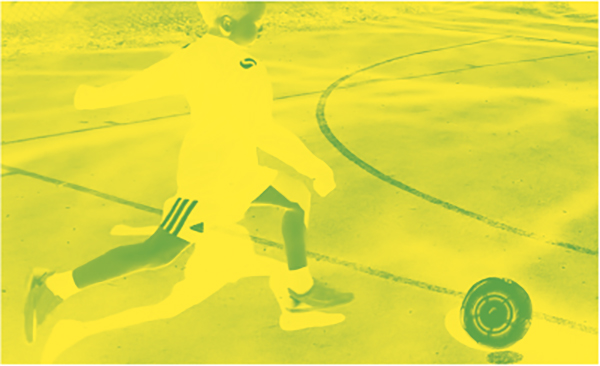
GHETTO CUP | KÒP GETO
This project aims to focus on health and the strength in unity by working with the community to use their love of football to host a street football tournament called the ‘Ghetto Cup’. There will also be a competition for design proposals for the ‘Ghetto Cup Trophy’’ and a fee will be paid for the winning creation. Prizes are also being considered: food hampers for the ‘Ghetto Cup’ football tournament team entrants, and monetary prize for the tournament winners and runner ups. It is hoped the competition will be embraced by the wider community whether as a competitor, official or spectator etc and continued every year as a sporting event held yearly under the ‘Ghetto Cup’ title.
There are many sporting initiatives around the world created to inspire people who are disadvantaged to change their own lives.
Research shows, ‘Living in a disadvantaged area hampers young people’s development: area-based deprivation is strongly related to higher crime, poorer educational achievement, health problems and high levels of disability. These factors have a knock-on effect on the local environment and community spirit, with residents in poor areas experiencing roughly four times more social and environmental problems than residents in more affluent areas. Sport and outdoor physical activity can have a positive impact on young people’s lives, yet youngsters living in disadvantaged areas face many barriers to participation.’ Child Poverty Action Group.
CPAG SPORT & POVERTY REPORT.PDF
The Ghetto Cup aims to address the negative effects that social exclusion has on health and well-being, and raise awareness to tackle some of the top causes of death in Haiti, which include:
• lschemic heart disease.
• Stroke
• Lower respiratory infections.
• Neo-natal disorders.
• Diabetes